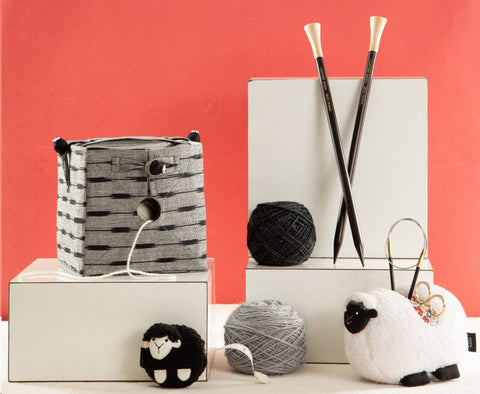
Garter, stockinette and reverse stockinette are basic stitch patterns in knitting. Once you learn to hold your knitting needles, master the knit and purl stitch you can easily work on knitting projects with these easy stitch patterns. While you may know about them and even have used them in various ways, it’s essential to understand the details so that you can plan your own projects. Another reason why it may assist you is that you will know where to work what and when to substitute. For example, a garter may bear a resemblance to a reverse stockinette but it's quite different. In this blog, join us as we unravel the workings of Garter, Stockinette and Reverse Stockinette.
What is the Garter Stitch?
The Garter stitch is a basic knitting pattern where you knit every row, creating a fabric with a uniform texture of horizontal ridges on both sides. It's simple, reversible, and doesn't curl at the edges. The most beginner-friendly knitting technique, it can be worked on for almost any project. For a detailed guide, check out our blog on how to knit the garter stitch.
If you are working on a garter with single pointed needles or circulars for back-and-forth knitting for projects such as a scarf; all you need to do is knit stitches every row.
Working the Garter stitch in the round with circular or double-pointed knitting needles is a bit different. As you are always working on the right side (RS) of the project, there’s no turning the project you need to work on purl stitches.
On the first round, knit all stitches.
On the second round, purl all stitches.
Repeat these two rounds (knit followed by purl) for the duration of your project. Working in alternate rounds, you create the ridged, textured appearance that is characteristic of the Garter stitch.
Uses of Garter Stitch
The Garter stitch is ideal for beginners due to its simplicity. It’s also excellent for projects where you want a fabric that doesn’t curl at the edges, such as blankets, scarves, and dishcloths. Its texture is forgiving, making it suitable for variegated or hand-dyed yarns.
What is the Stockinette Stitch?
Another basic stitch pattern in knitting, stockinette works with alternating rows of knit and purl stitches. The fabric is not reversible as the right side (RS) shows knit stitches while the wrong side displays purls.
If you are working with single-pointed needles, you start by cast on and then work on a row of knit stitches. After the row is finished, you turn your project and now work on a row of purl stitches. Our beginner's guide to knit the stockinette stitch will assist you.
Uses of Stockinette Stitch
Stockinette stitch is versatile and often used in garments like sweaters, hats, and socks. Its smooth surface showcases yarns beautifully, making it ideal for patterns that feature colorwork or textured yarns. However, be mindful of the tendency for stockinette to curl, especially on the edges, which can be mitigated with border treatments or blocking.
What is Reverse Stockinette?
Reverse stockinette stitch is the opposite of stockinette. Here the purl side faces outward while the knit side is inside. In this stitch, the appearance of knit stitches is reversed, making them look like purl stitches on the right side of the work.
Reverse Stockinette Stitch is a non-reversible knitting pattern to alternate between knit and purl stitches to achieve the unique Reverse Stockinette pattern on the right side of your project:
Row 1 after cast on (WS): Knit all stitches, turn your work.
Row 2: (RS): Purl all stitches,
Repeat rows 1 and 2.
Similar to stockinette, working reverse stockinette in round is different from back and forth knitting. To know more, follow our previous blog on how to work reverse stockinette stitch in rounds.
Uses of Reverse Stockinette Stitch
This technique is beneficial for items like sweaters, socks, knitted belts, and hats where you might want the texture of the Reverse Stockinette stitch on the piece's exterior.
Reverse stockinette stitch is often used in combination with stockinette stitch to create textured patterns or contrast in garments. It’s also a good choice for projects where you want a more subtle texture without the pronounced curls of stockinette stitch. This pattern is commonly used in accessories like shawls and blankets to add interest and variation.
Garter vs Stockinette/ Reverse Stockinette

Garter creates a fabric that has a uniform texture with a "bump" with rows of horizontal ridges. While garter stitch is reversible, meaning both sides of the fabric look the same, and it doesn't curl at the edges as the Stockinette or Reverse Stockinette stitch does. Bearing a striking resemblance to the garter, reverse stockinette pattern as fabric features the "bumps" visible on the right side of the work, creating a textured, bumpy surface while the wrong side of the fabric appears smooth and has a "V" pattern created by the knit stitches. Stockinette stays clear out with its distinct appearance of “Vs” of the knit stitches on the right side (RS) of the project.
With this handy guide and the best knitting needles from Lantern Moon, you're well-equipped to explore the vast, creative possibilities of crafting the Garter stitch, Stockinette and Reverse Stockinette. The smooth ebony wood knitting needle sets cater to every knitting need, ensuring you have the perfect tool for every project, whether you're working on a flat piece or knitting in the round. Get ready to explore your creative potential!
